PEUGEOT PARTNER TEPEE ELECTRIC 2017 Owners Manual
Manufacturer: PEUGEOT, Model Year: 2017, Model line: PARTNER TEPEE ELECTRIC, Model: PEUGEOT PARTNER TEPEE ELECTRIC 2017Pages: 252, PDF Size: 9.89 MB
Page 131 of 252
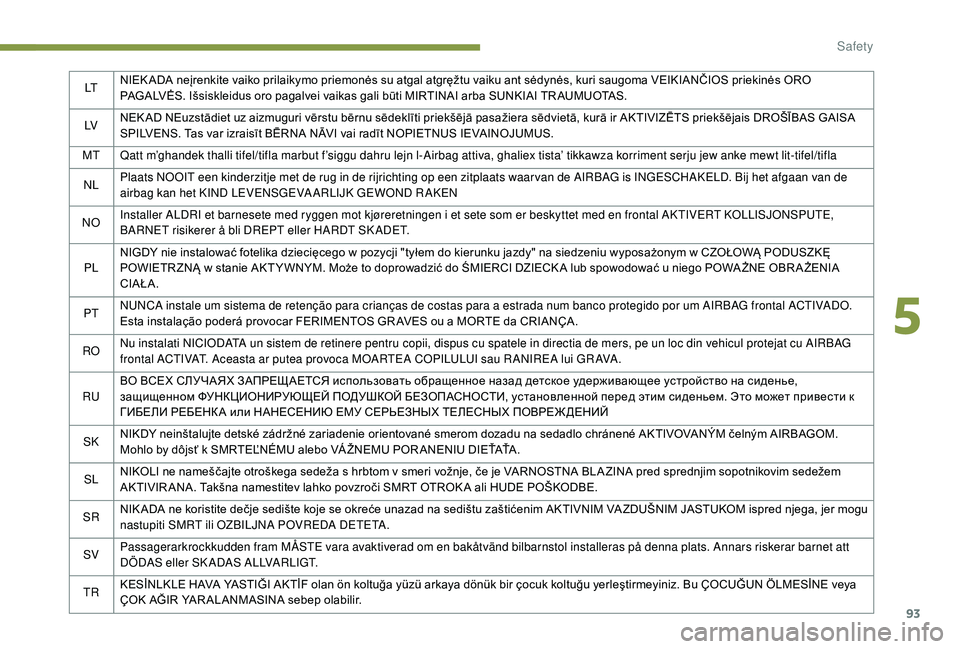
93
LTNIEK ADA neįrenkite vaiko prilaikymo priemonės su atgal atgręžtu vaiku ant sėdynės, kuri saugoma VEIKIANČIOS priekinės ORO
PAGALVĖS. Išsiskleidus oro pagalvei vaikas gali būti MIRTINAI arba SUNKIAI TR AUMUOTAS.
LV NEK AD NEuzstādiet uz aizmuguri vērstu bērnu sēdeklīti priekšējā pasažiera sēdvietā, kurā ir AKTIVIZĒTS priekšējais DROŠĪBAS GAISA
SPILVENS. Tas var izraisīt BĒRNA NĀVI vai radīt NOPIETNUS IEVAINOJUMUS.
MT Qatt m’ghandek thalli tifel/tifla marbut f’siggu dahru lejn l-Airbag attiva, ghaliex tista’ tikkawza korriment serju jew anke mewt lit-tifel/tifla
NL Plaats NOOIT een kinderzitje met de rug in de rijrichting op een zitplaats waar van de AIRBAG is INGESCHAKELD. Bij het afgaan van de
airbag kan het KIND LEVENSGEVA ARLIJK GEWOND R AKEN
NO Installer ALDRI et barnesete med ryggen mot kjøreretningen i et sete som er beskyttet med en frontal AKTIVERT KOLLISJONSPUTE,
BARNET risikerer å bli DREPT eller HARDT SK ADET.
PL NIGDY nie instalować fotelika dziecięcego w pozycji "tyłem do kierunku jazdy" na siedzeniu wyposażonym w CZOŁOWĄ PODUSZKĘ
POWIETRZNĄ w stanie AKT Y WNYM. Może to doprowadzić do ŚMIERCI DZIECK A lub spowodować u niego POWA ŻNE OBR A ŻENIA
CIAŁA.
PT NUNCA instale um sistema de retenção para crianças de costas para a estrada num banco protegido por um AIRBAG frontal ACTIVADO.
Esta instalação poderá provocar FERIMENTOS GR AVES ou a MORTE da CRIANÇA.
RO Nu instalati NICIODATA un sistem de retinere pentru copii, dispus cu spatele in directia de mers, pe un loc din vehicul protejat cu AIRBAG
frontal ACTIVAT. Aceasta ar putea provoca MOARTEA COPILULUI sau R ANIREA lui GR AVA.
RU ВО ВСЕХ СЛУЧА ЯХ ЗАПРЕЩАЕТСЯ использовать обращенное назад детское удерживающее устройство на сиденье,
защищенном ФУНКЦИОНИРУЮЩЕЙ ПОДУШКОЙ БЕЗОПАСНОСТИ, установленной перед этим сиденьем. Это может привести к
ГИБЕЛИ РЕБЕНК А или НАНЕСЕНИЮ ЕМУ СЕРЬЕЗНЫХ ТЕЛЕСНЫХ ПОВРЕЖ ДЕНИЙ
SK NIKDY neinštalujte detské zádržné zariadenie orientované smerom dozadu na sedadlo chránené AKTIVOVANÝM čelným AIRBAGOM.
Mohlo by dôjsť k SMRTEĽNÉMU alebo VÁ ŽNEMU POR ANENIU DIEŤAŤA.
SL NIKOLI ne nameščajte otroškega sedeža s hrbtom v smeri vožnje, če je VARNOSTNA BLA ZINA pred sprednjim sopotnikovim sedežem
AKTIVIR ANA. Takšna namestitev lahko povzroči SMRT OTROK A ali HUDE POŠKODBE.
SR NIK ADA ne koristite dečje sedište koje se okreće unazad na sedištu zaštićenim AKTIVNIM VA ZDUŠNIM JASTUKOM ispred njega, jer mogu
nastupiti SMRT ili OZBILJNA POVREDA DETETA.
SV Passagerarkrockkudden fram MÅSTE vara avaktiverad om en bakåtvänd bilbarnstol installeras på denna plats. Annars riskerar barnet att
DÖDAS eller SK ADAS ALLVARLIGT.
TR KESİNLKLE HAVA YASTIĞI AKTİF olan ön koltuğa yüzü arkaya dönük bir çocuk koltuğu yerleştirmeyiniz. Bu ÇOCUĞUN ÖLMESİNE veya
ÇOK AĞIR YAR ALANMASINA sebep olabilir.
5
Safety
Page 132 of 252
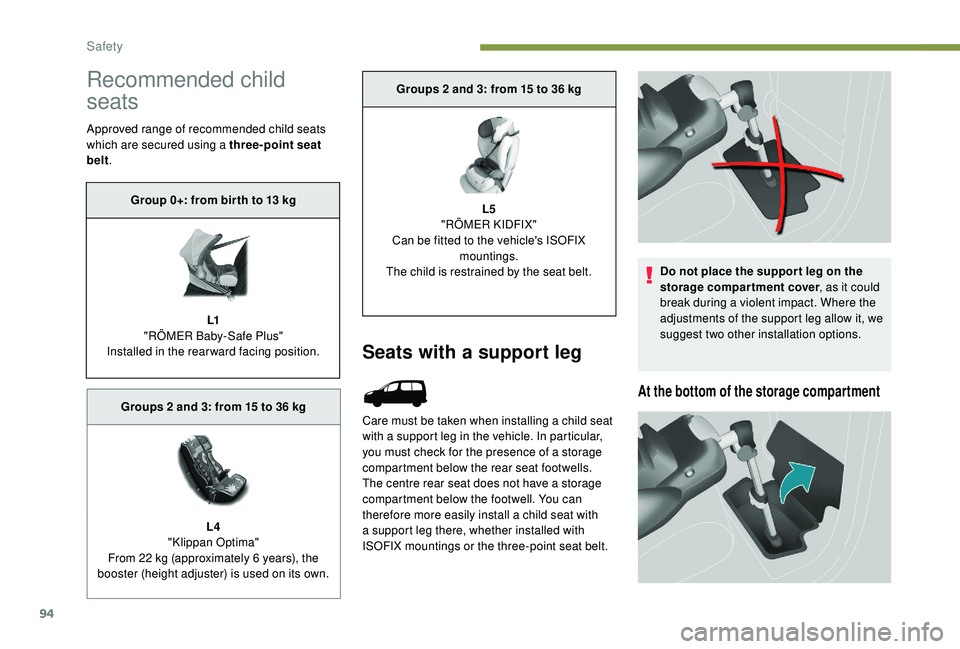
94
Recommended child
seats
Approved range of recommended child seats
which are secured using a three-point seat
belt.
Seats with a support leg
Care must be taken when installing a child seat
with a support leg in the vehicle. In particular,
you must check for the presence of a storage
compartment below the rear seat footwells.
The centre rear seat does not have a storage
compartment below the footwell. You can
therefore more easily install a child seat with
a support leg there, whether installed with
ISOFIX mountings or the three-point seat belt. Do not place the suppor t leg on the
storage compartment cover
, as it could
break during a violent impact. Where the
adjustments of the support leg allow it, we
suggest two other installation options.
At the bottom of the storage compartment
Group 0+: from bir th to 13 kg
L1
"
RÖMER Baby-Safe Plus"
Installed in the rearward facing position.
Groups 2 and 3: from 15 to 36
kg
L4
"Klippan Optima"
From 22
kg (approximately 6 years), the
booster (height adjuster) is used on its own. Groups 2 and 3: from 15 to 36
kg
L5
"RÖMER KIDFIX"
Can be fitted to the vehicle's ISOFIX mountings.
The child is restrained by the seat belt.
Safety
Page 133 of 252
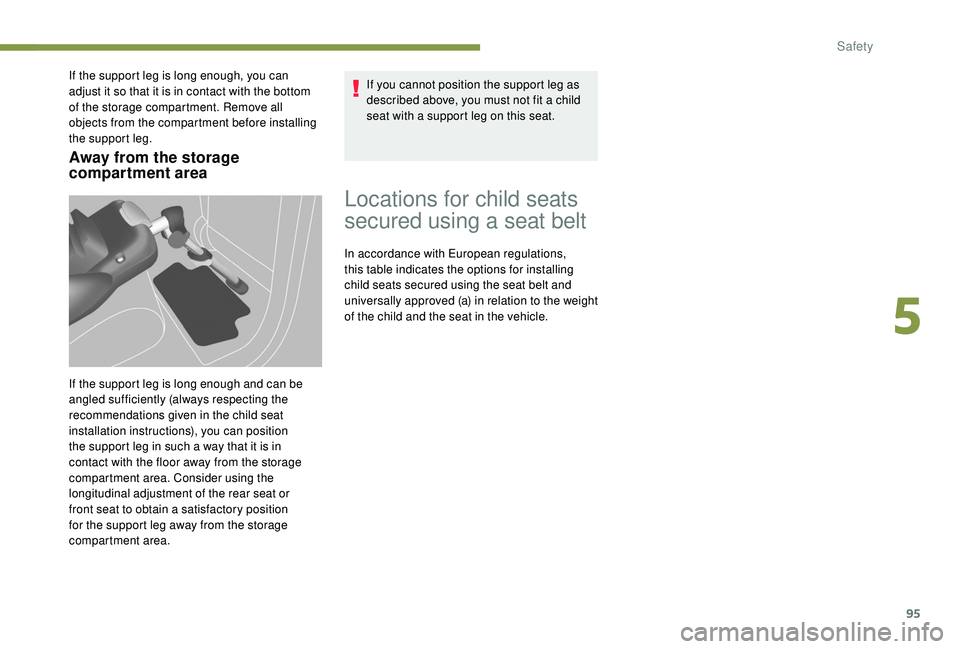
95
Away from the storage
compartment area
If the support leg is long enough, you can
adjust it so that it is in contact with the bottom
of the storage compartment. Remove all
objects from the compartment before installing
the support leg.
If the support leg is long enough and can be
angled sufficiently (always respecting the
recommendations given in the child seat
installation instructions), you can position
the support leg in such a way that it is in
contact with the floor away from the storage
compartment area. Consider using the
longitudinal adjustment of the rear seat or
front seat to obtain a satisfactory position
for the support leg away from the storage
compartment area.If you cannot position the support leg as
described above, you must not fit a child
seat with a support leg on this seat.
Locations for child seats
secured using a seat belt
In accordance with European regulations,
this table indicates the options for installing
child seats secured using the seat belt and
universally approved (a) in relation to the weight
of the child and the seat in the vehicle.
5
Safety
Page 134 of 252
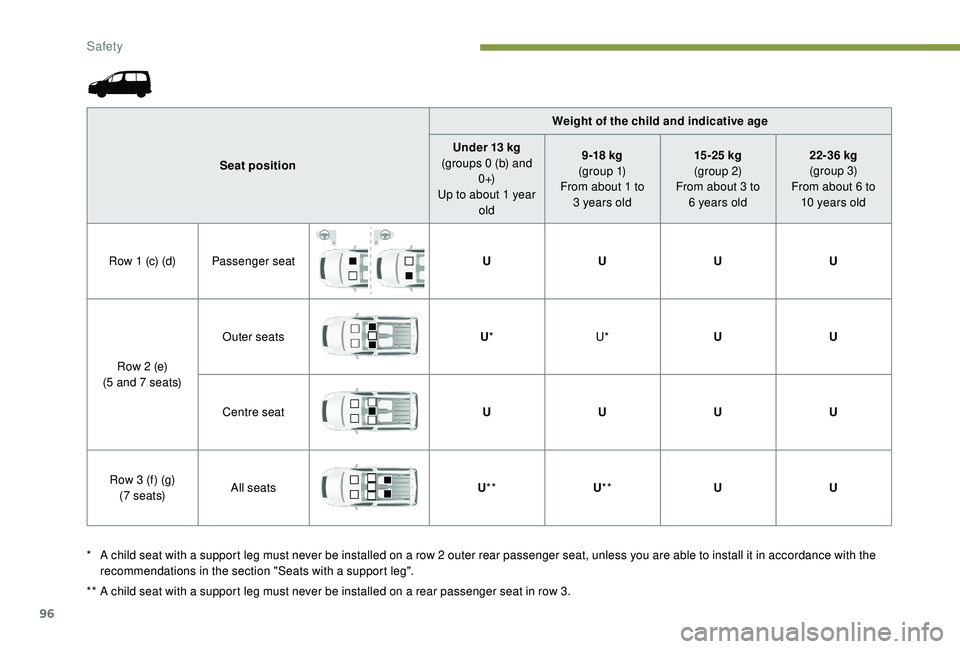
96
Weight of the child and indicative age
Seat position Under 13
kg
(groups 0 (b) and 0 +)
Up to about 1 year old 9 -18
kg
(g r o u p 1)
From about 1 to 3
years old 15 -25
kg
(group 2)
From about 3 to 6
years old22-36
kg
(group 3)
From about 6 to 10
years old
Row 1 (c) (d) Passenger seat UUUU
Row 2 (e)
(5 and 7 seats) Outer seats
U* U* UU
Centre seat UUUU
Row 3 (f) (g) (7 seats) All seats
U** U** U U
*
A c
hild seat with a support leg must never be installed on a row 2 outer rear passenger seat, unless you are able to install it in accordance with the
recommendations in the section "Seats with a support leg".
**
A c
hild seat with a support leg must never be installed on a rear passenger seat in row 3.
Safety
Page 135 of 252
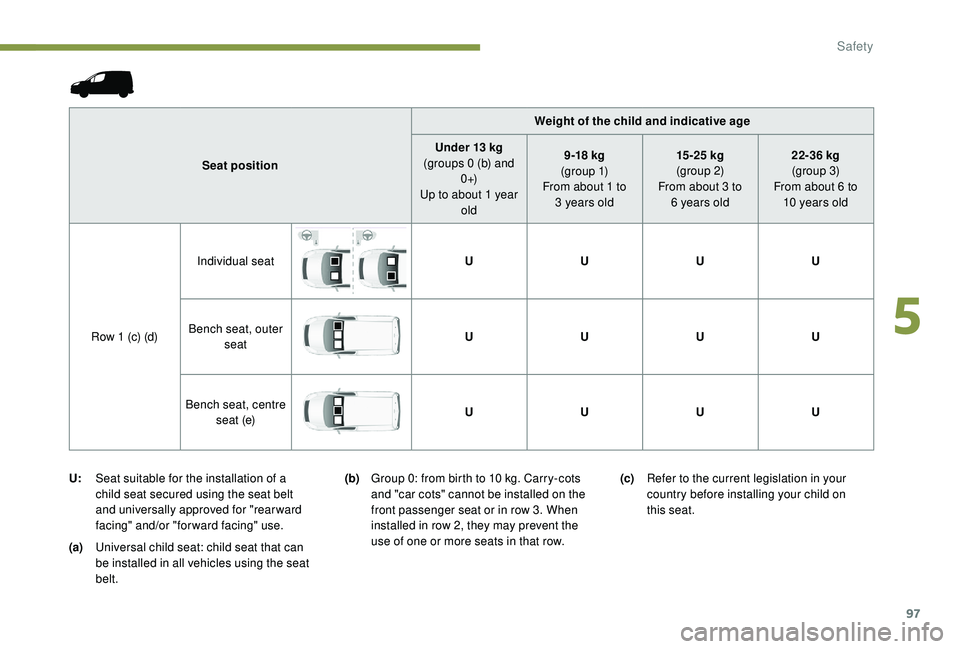
97
(a)Universal child seat: child seat that can
be installed in all vehicles using the seat
belt. Weight of the child and indicative age
Seat position Under 13 kg
(groups 0 (b) and 0 +)
Up to about 1 year old 9 -18
kg
(g r o u p 1)
From about 1 to 3 years old
15 -25
kg
(group 2)
From about 3 to 6 years old
22-36 kg
(group 3)
From about 6 to 10 years old
Row 1 (c) (d) Individual seat
UUUU
Bench seat, outer seat U
UUU
Bench seat, centre seat (e) U
UUU
(b) Group 0: from birth to 10 kg. Carry-cots
and "car cots" cannot be installed on the
front passenger seat or in row 3. When
installed in row 2, they may prevent the
use of one or more seats in that row. (c)
Refer to the current legislation in your
country before installing your child on
this seat.
U:
Seat suitable for the installation of a
child seat secured using the seat belt
and universally approved for "rearward
facing" and/or "forward facing" use.
5
Safety
Page 136 of 252
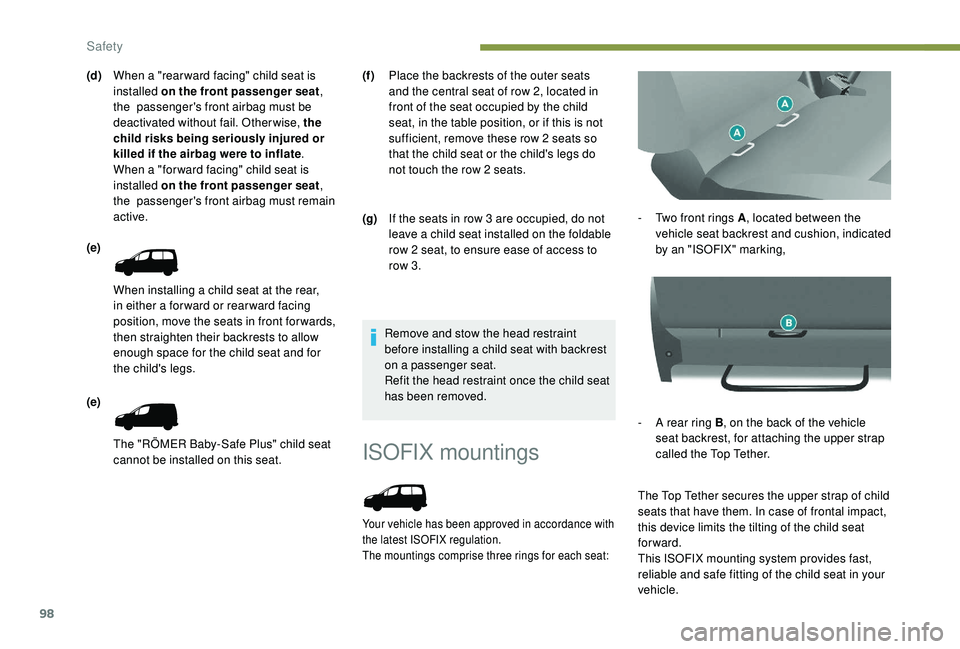
98
ISOFIX mountings
Your vehicle has been approved in accordance with
the latest ISOFIX regulation.
The mountings comprise three rings for each seat:
- Two front rings A, located between the
vehicle seat backrest and cushion, indicated
by an "ISOFIX" marking,
-
A r
ear ring B , on the back of the vehicle
seat backrest, for attaching the upper strap
called the Top Tether.
The Top Tether secures the upper strap of child
seats that have them. In case of frontal impact,
this device limits the tilting of the child seat
forward.
This ISOFIX mounting system provides fast,
reliable and safe fitting of the child seat in your
vehicle.
Remove and stow the head restraint
before installing a child seat with backrest
on a passenger seat.
Refit the head restraint once the child seat
has been removed.
(d)
When a "rear ward facing" child seat is
installed on the front passenger seat ,
the passenger's front airbag must be
deactivated without fail. Otherwise, the
child risks being seriously injured or
killed if the airbag were to inflate .
When a "for ward facing" child seat is
installed on the front passenger seat ,
the passenger's front airbag must remain
active.
(e)
When installing a child seat at the rear,
in either a for ward or rear ward facing
position, move the seats in front for wards,
then straighten their backrests to allow
enough space for the child seat and for
the child's legs.
(e)
The "RÖMER Baby-Safe Plus" child seat
cannot be installed on this seat. (f )
Place the backrests of the outer seats
and the central seat of row 2, located in
front of the seat occupied by the child
seat, in the table position, or if this is not
sufficient, remove these row 2 seats so
that the child seat or the child's legs do
not touch the row 2 seats.
(g) If the seats in row 3 are occupied, do not
leave a child seat installed on the foldable
row 2 seat, to ensure ease of access to
row 3.
Safety
Page 137 of 252
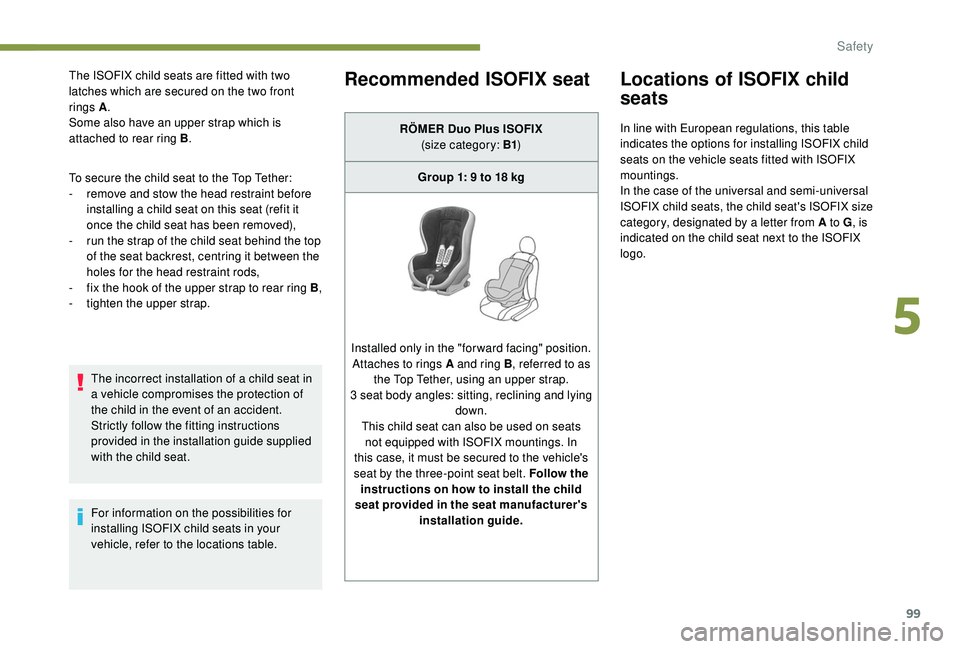
99
The ISOFIX child seats are fitted with two
latches which are secured on the two front
rings A.
Some also have an upper strap which is
attached to rear ring B .
To secure the child seat to the Top Tether:
-
r
emove and stow the head restraint before
installing a child seat on this seat (refit it
once the child seat has been removed),
-
r
un the strap of the child seat behind the top
of the seat backrest, centring it between the
holes for the head restraint rods,
-
f
ix the hook of the upper strap to rear ring B ,
-
t
ighten the upper strap.The incorrect installation of a child seat in
a vehicle compromises the protection of
the child in the event of an accident.
Strictly follow the fitting instructions
provided in the installation guide supplied
with the child seat.
For information on the possibilities for
installing ISOFIX child seats in your
vehicle, refer to the locations table.Recommended ISOFIX seat Locations of ISOFIX child seats
In line with European regulations, this table
indicates the options for installing ISOFIX child
seats on the vehicle seats fitted with ISOFIX
mountings.
In the case of the universal and semi-universal
ISOFIX child seats, the child seat's ISOFIX size
category, designated by a letter from A to G , is
indicated on the child seat next to the ISOFIX
logo.
RÖMER Duo Plus ISOFIX
(size category: B1 )
Group 1: 9 to 18
kg
Installed only in the "forward facing" position. Attaches to rings A and ring B , referred to as
the Top Tether, using an upper strap.
3 seat body angles: sitting, reclining and lying down.
This child seat can also be used on seats not equipped with ISOFIX mountings. In
this case, it must be secured to the vehicle's
seat by the three-point seat belt. Follow the instructions on how to install the child
seat provided in the seat manufacturer's installation guide.
5
Safety
Page 138 of 252
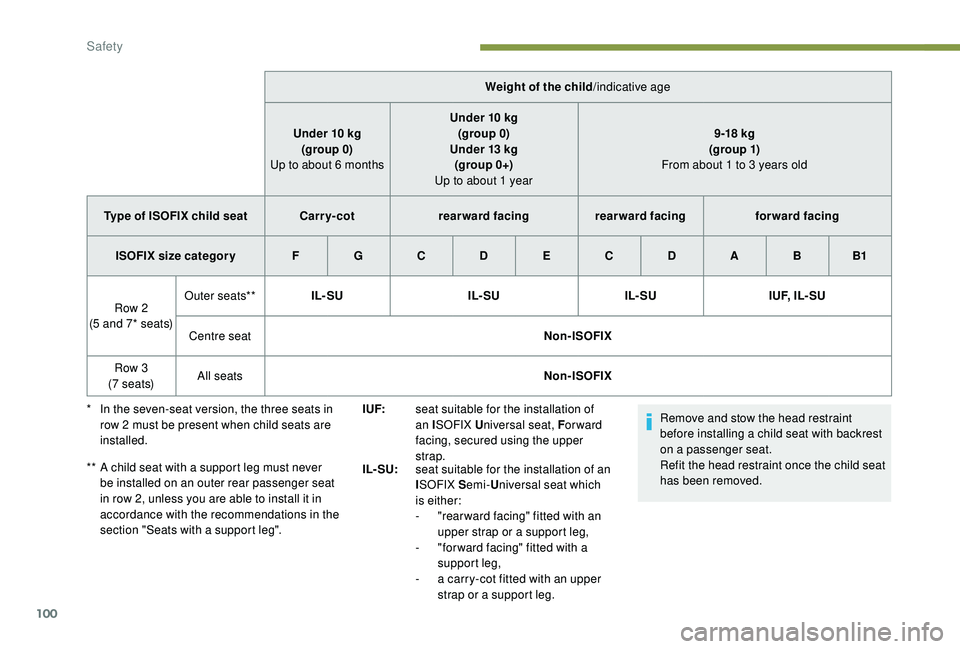
100
Remove and stow the head restraint
before installing a child seat with backrest
on a passenger seat.
Refit the head restraint once the child seat
has been removed.
Weight of the child
/indicative age
Under 10
kg
(group 0)
Up to about 6
months
Under 10
kg
(group 0)
Under 13
kg
(group 0+)
Up to about 1 year 9 -18
kg
(g ro up 1)
From about 1 to 3 years old
Type of ISOFIX child seat Carr y- cotrearward facing rearward facing forward facing
ISOFIX size categor y F G C D E C D A B B1
Row 2
(5 and 7* seats) Outer seats**
IL- SU IL- SUIL- SUI U F, I L - S U
Centre seat Non-ISOFIX
Row 3
(7 seats) All seats
Non-ISOFIX
*
I
n the seven-seat version, the three seats in
row 2
must be present when child seats are
installed.
**
A c
hild seat with a support leg must never
be installed on an outer rear passenger seat
in row 2, unless you are able to install it in
accordance with the recommendations in the
section "Seats with a support leg". I UF:
seat suitable for the installation of
an ISOFIX U niversal seat, F or ward
facing, secured using the upper
strap.
IL- SU: seat suitable for the installation of an
ISOFIX S emi-Universal seat which
is either:
-
"
rear ward facing" fitted with an
upper strap or a support leg,
-
"
for ward facing" fitted with a
support leg,
-
a c
arry-cot fitted with an upper
strap or a support leg.
Safety
Page 139 of 252
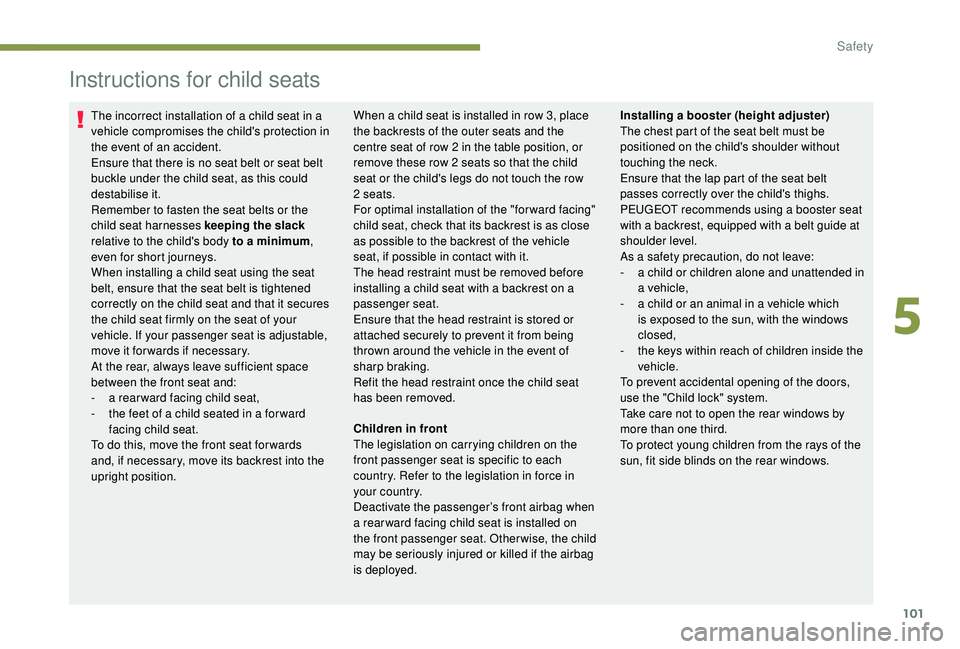
101
Instructions for child seats
The incorrect installation of a child seat in a
vehicle compromises the child's protection in
the event of an accident.
Ensure that there is no seat belt or seat belt
buckle under the child seat, as this could
destabilise it.
Remember to fasten the seat belts or the
child seat harnesses keeping the slack
relative to the child's body to a minimum,
even for short journeys.
When installing a child seat using the seat
belt, ensure that the seat belt is tightened
correctly on the child seat and that it secures
the child seat firmly on the seat of your
vehicle. If your passenger seat is adjustable,
move it for wards if necessary.
At the rear, always leave sufficient space
between the front seat and:
-
a r
ear ward facing child seat,
-
t
he feet of a child seated in a for ward
facing child seat.
To do this, move the front seat for wards
and, if necessary, move its backrest into the
upright position. When a child seat is installed in row 3, place
the backrests of the outer seats and the
centre seat of row 2 in the table position, or
remove these row 2 seats so that the child
seat or the child's legs do not touch the row
2 seats.
For optimal installation of the "forward facing"
child seat, check that its backrest is as close
as possible to the backrest of the vehicle
seat, if possible in contact with it.
The head restraint must be removed before
installing a child seat with a backrest on a
passenger seat.
Ensure that the head restraint is stored or
attached securely to prevent it from being
thrown around the vehicle in the event of
sharp braking.
Refit the head restraint once the child seat
has been removed.
Installing a booster (height adjuster)
The chest part of the seat belt must be
positioned on the child's shoulder without
touching the neck.
Ensure that the lap part of the seat belt
passes correctly over the child's thighs.
PEUGEOT recommends using a booster seat
with a backrest, equipped with a belt guide at
shoulder level.
As a safety precaution, do not leave:
-
a c
hild or children alone and unattended in
a vehicle,
-
a c
hild or an animal in a vehicle which
is exposed to the sun, with the windows
closed,
-
t
he keys within reach of children inside the
vehicle.
To prevent accidental opening of the doors,
use the "Child lock" system.
Take care not to open the rear windows by
more than one third.
To protect young children from the rays of the
sun, fit side blinds on the rear windows.
Children in front
The legislation on carrying children on the
front passenger seat is specific to each
country. Refer to the legislation in force in
your country.
Deactivate the passenger’s front airbag when
a rear ward facing child seat is installed on
the front passenger seat. Otherwise, the child
may be seriously injured or killed if the airbag
is deployed.
5
Safety
Page 140 of 252
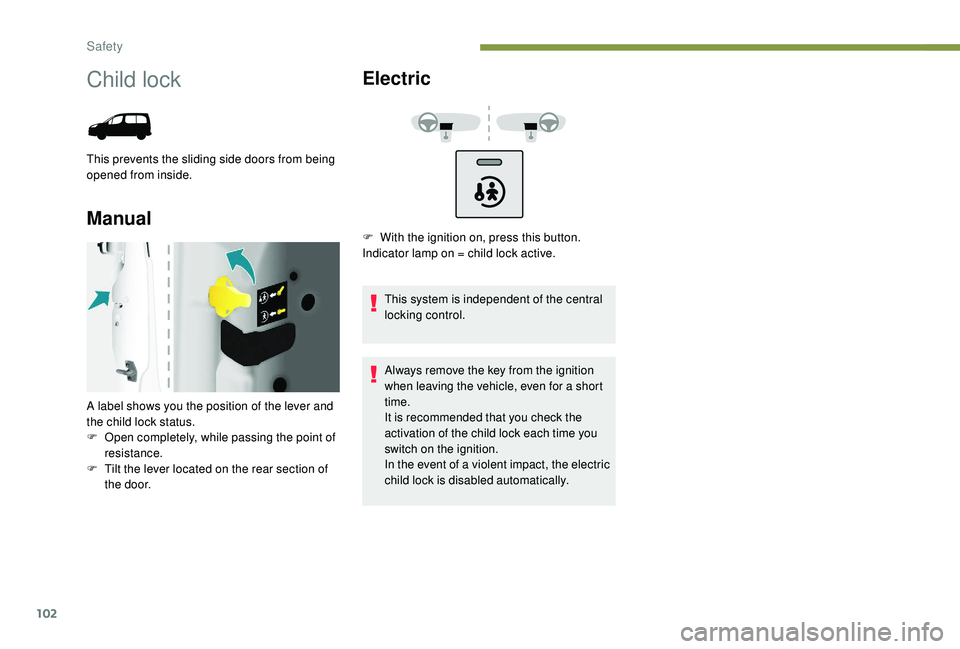
102
Child lock
This prevents the sliding side doors from being
opened from inside.
ManualElectric
This system is independent of the central
locking control.
Always remove the key from the ignition
when leaving the vehicle, even for a short
time.
It is recommended that you check the
activation of the child lock each time you
switch on the ignition.
In the event of a violent impact, the electric
child lock is disabled automatically.
A label shows you the position of the lever and
the child lock status.
F
O
pen completely, while passing the point of
resistance.
F
T
ilt the lever located on the rear section of
the door. F
W
ith the ignition on, press this button.
Indicator lamp on = child lock active.
Safety